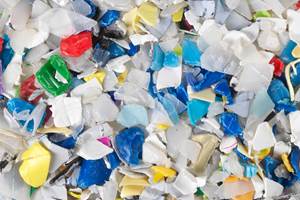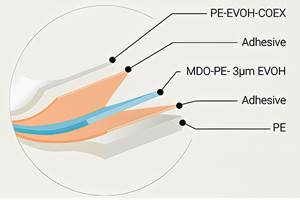PE Film Market Snap-Shot: T-Shirt Bags
Downgauging is a key trend: the average PE t-shirt bag utilizes 30% less material than a bag made five years ago, due mostly to advances in resin technology.
Last week we reported on the results of 2017 research conducted by market-research firm Mastio & Co., St. Joseph, Mo. on the PE film industry, focusing on stretch film.
Here, we recap Mastio’s research on another huge segment of the PE film business: t-shirt bags, also known as grocery sacks.
During 2017, approximately 1.270 million lb of PE resins were consumed in the North American production of t-shirt bags. With an average annual growth rate (AAGR) of 1.3%, PE resin consumption for t-shirt bags is expected to increase to about 1.318 million lb by 2020.
There are three typical t-shirt bag sizes: 1/6 barrel, 1/7 barrel, and 1/8 barrel, Mastio reports. The 1/6 barrel is the most common at 12 in. x 7 in. x 23.0 in. A 1/6-barrel bag can hold more than 25 lb of groceries, which is twice the weight of an average filled paper sack, and more than the average person would prefer to carry.
T-shirt bags are commonly packaged 1000 bags per case, weighing approximately 12 to 15 lb per case, the Mastio study reports. T-shirt bags are bottom sealed via heat and pressure. The pressure seal produces less bulk, allowing for more bags to be mounted on wickets. T-shirt bags are usually side gusseted and have features such as self-opening tabs and non-tabbed openings. Tabbed style sacks are represented by an additional round of plastic that forms a tab opening at the top center of the bag. The tab slit-like opening is fed through a bag system or rack, making the bag easier to open. Many bags can be placed on the system at one time. Non-tabbed style sacks simply have a slit-like opening in the top center of the bag. The non-tabbed style bag is claimed to be the most preferred t-shirt bag style because it is easier to open versus the tabbed style bag, which has a more complex design.
Most bagmakers print on their t-shirt bags. The flexographic printing process is the most widely utilized in this market. The number of colors used while printing generally ranges from one to six. Film manufacturers in this market utilize the in-line printing method more frequently than the offline printing mode.
MATERIAL TRENDS
Historically, Kraft paper was the primary competing material of PE film in the production of grocery sacks. Some consumers choose a paper bag because they believe it is a more natural and environmentally safe bag. As Mastio points out, they don’t realize paper manufacturing pollutes the water, releases dioxin into the atmosphere, contributes to acid rain, and depletes the tree population. Primarily, paper sacks are currently used to provide an alternative option to customers.
Paper sacks also cost more to purchase when compared to plastic t-shirt bags. To maintain reasonable profit levels, grocery stores must select products with a lower price. PE sacks are not only less costly to purchase, but they are less expensive to transport and require less space to inventory. Although paper sacks are still widely carried, many grocery stores have converted to plastic to increase profitability.
PE t-shirt bags consume 40.0% less energy than paper when produced, and generate 80.0% less solid waste than paper bags. Fewer atmospheric emissions are produced and less waterborne wastes are released with PE t-shirt bag production compared to paper bag production.
Currently, reusable cloth sacks continue to make inroads into this market due to the pressure from several state and city governments. Many states and cities are in the process or have already enacted legislation on single-use, paper and plastic bags that varies from an all-out ban to imposing a tax or bag fee on each bag at the point of sale. As a result, many stores are now selling their own reusable cloth or plastic sacks to consumers, says Mastio.
Among PE types, Mastio reports that in 2017 t-shirt bags were primarily constructed of HMW-HDPE and UHMW-HDPE. However, some film producers manufacture plastic t-shirt bags using LLDPE) and/or LDPE. HMW-HDPE resin is utilized due to its superior strength in thinner gauges than is possible with LLDPE or LDPE resins. HDPE resins, particularly HMW-HDPE and UHMW-HDPE grades, maintain the desired strength levels when downgauged, and have very high impact resistance.
TECHNOLOGY TRENDS
This is a blown film market, still mostly monolayer, according to Mastio. Downgauging is a key trend: On average PE t-shirt bags utilize 30% less material than bags made five years ago, due mostly to advances in resin technology.
MY TWO CENTS
Like stretch film, the t-shirt market is dominated by a few major processors. According to Mastio’s data, the top five producers of PE t-shirt bags in North America—Novolex; Advance Polybag Inc.; Inteplast Group Ltd; Superbag Corp.; and Durabag Co. Inc. collectively processed 1,126.8 million lb of PE resins in the production of t-shirt bags for a combined market share of 88.8%.
Some processors who participated in the Mastio study believe that bans and other legislative action on t-shirt bags will hinder growth in this market. That said numerous manufacturers of PE t-shirt bags are involved in recycling efforts. Collection bins are often located inside grocery stores. This creates a closed loop market in which the company that produced the bag also collects it from the recycle bin within the store where the bag was purchased. Some years back, Plastics Technology reported on the efforts of Novolex in this area. Expect more of these types of recycling initatives as processors continue efforts to make this type of bag production a viable business.
Read the Stretch Film Market Report.
Related Content
Looking to Run PCR on a Single Screw? Here’s What to Keep in Mind
Just drop it in and mix it up? Sorry, there’s a lot more to it than that. Here is some of what you need to consider.
Read MoreRecycling Terminology Can Be a Minefield, So We Should Tread Lightly
Loose propagation of terms like “recyclable” and “compostable” has already brought down government regulations on labeling. The plastics and packaging industries should take that to heart with other recycle-related language. Like “monomaterial” for example.
Read MoreMultilayer Solutions to Challenges in Blow Molding with PCR
For extrusion blow molders, challenges of price and availability of postconsumer recycled resins can be addressed with a variety of multilayer technologies, which also offer solutions to issues with color, processability, mechanical properties and chemical migration in PCR materials.
Read MoreEvolving Opportunities for Ambitious Plastics Recycler
St. Joseph Plastics grew from a simple grinding operation and now pursues growing markets in recycled PP, food-grade recycled materials, and customized post-industrial and post-consumer compounds.
Read MoreRead Next
Beyond Prototypes: 8 Ways the Plastics Industry Is Using 3D Printing
Plastics processors are finding applications for 3D printing around the plant and across the supply chain. Here are 8 examples to look for at NPE2024.
Read MoreFor PLASTICS' CEO Seaholm, NPE to Shine Light on Sustainability Successes
With advocacy, communication and sustainability as three main pillars, Seaholm leads a trade association to NPE that ‘is more active today than we have ever been.’
Read More

























